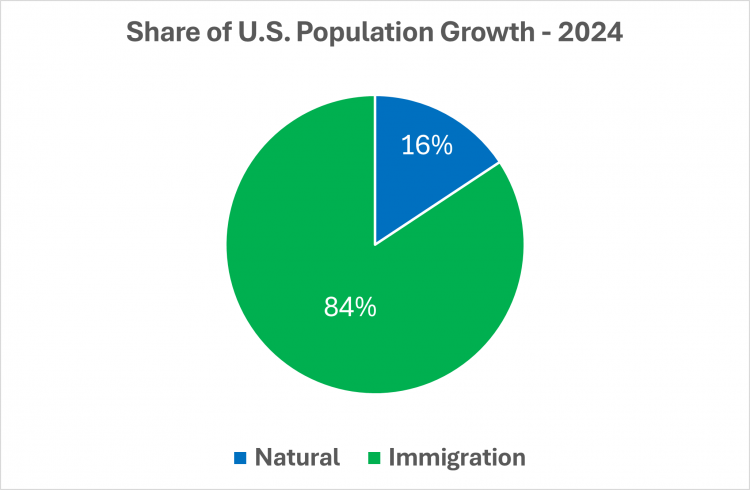Civilization
Immigration Continues To Drive U.S. Population Growth
Immigration is the chief driver of population growth in the United States today, amounting to 84 percent of total growth.

The U.S. Census Bureau just released its population estimates for 2024. It estimated that the nation’s population grew by nearly 1%, adding about 3.3 million people. Of that increase, however, 84% was from immigration (2.8 million). Without immigration, the population would have only grown by about .15% (518,000).
Is immigration underestimated?

However, this probably understates the effect of immigration on U.S. population growth. First, more recent immigrants tend to have a higher birth rate than other U.S. residents. This study found that in 2019, the fertility rate for Americans born here was 1.69 compared to 2.02 for immigrants. In other words, immigrants are propping up the natural population growth.
Second, the Census Bureau’s immigration numbers have been widely criticized as being too low. Last year, when the Census Bureau estimated that net international immigration into the U.S. was 1.2 million, the Congressional Budget Office estimated it was 4 million. So the Census Bureau’s estimate this year of 2.8 million sounds more reasonable. Our immigration system is so broken that no one knows the actual number, but it is quite likely that if the U.S. were to stop all immigration today, our population would be falling.
Every state added population from international immigration. At 411,000, Florida had the most new residents from other countries, with New York a close second at 389,000. Texas had a 311,000 increase from international immigration. International immigration comprised 88% of Florida’s total growth but only 56% of Texas’ growth.
Less moving between States
Only three states (Mississippi, Vermont, and West Virginia) lost population last year, but their losses were minimal. However, without international immigration, 20 states would have lost population. California would have been the biggest loser at 129,000. New York, Pennsylvania, Illinois, and Massachusetts rounded out the top five in this category. The 20 states that would have lost population without immigration would have lost a total of 385,000.
There was significantly less moving between states by Americans last year. In 2023, about 1.75 million people moved from one state to another. This year that dropped to 1.15 million, which is about a 34% decline. There has been a decline in interstate migration for several decades, most likely due to an aging population. However, this is an unusually large drop for one year. There has been some speculation about the cause and whether this represents a more persistent trend, but I was unable to find any hard data to explain this year’s drop. The ability to work remotely and, therefore, less need to relocate for a job is probably a factor.
Texas led other states by gaining 85,000 residents. However, that was less than half its gain from domestic immigration last year. North Carolina was a close second at 82,000. South Carolina, Florida, and Tennessee were third through fifth, respectively. Florida had a jaw-dropping 65% decline in domestic immigration (185,000 → 65,000).
California lost the most
California continued to lead the way in losing residents, shedding 240,000. New York lost 120,000. Illinois, New Jersey, and Massachusetts also had significant losses. Louisiana and Mississippi were the only southern states that lost residents to other states.
The new data strongly suggests that assuming the new Trump administration even comes close to making good immigration reforms and deportation promises, there will likely be some significant declines in the U.S. population. The declines will reach almost every region and significantly impact the country. There will certainly be some benefits from a declining population, but there will also be some significant and painful disruptions. There will almost certainly be labor shortages in many industries and a significant decline in economic growth.
Polling has consistently shown that Trump’s more restrictive immigration policy has widespread support in the country across almost every demographic. It will be interesting to see whether the support continues as the reality of population decline begins to be felt.
This article was originally published by RealClearPolitics and made available via RealClearWire.
Bill King is a businessman and lawyer, and is a former opinion columnist and editorial board member at the Houston Chronicle. He has served in a number of appointed and elected positions, including mayor of his hometown. He writes on a wide range of public policy and political issues. Bill is the author of “Unapologetically Moderate” and currently serves as the co-chair of the Forward Party of Texas.
-

 Civilization4 days ago
Civilization4 days agoDC Pipe Bomb Arrest Raises Questions About Christopher’s Wray’s FBI
-

 Civilization5 days ago
Civilization5 days agoThe Legal Logic Behind U.S. Operations Against Narco-Terrorist Networks
-

 Executive5 days ago
Executive5 days agoNewsom’s ‘National Model’ for Homeless Wracked by Fraud
-

 Executive4 days ago
Executive4 days agoWhen You’re in a Hole, Stop Digging
-

 Executive2 days ago
Executive2 days agoWaste of the Day: Obamacare Failed Test, Approved Fraudulent Subsidies
-

 Education3 days ago
Education3 days agoWaste of the Day: Taxpayers Subsidize Football Coach Severance
-

 Civilization3 days ago
Civilization3 days agoPence Calls on Trump To Fire RFK Jr Over Abortion Drug
-

 Civilization3 days ago
Civilization3 days agoRight-Wing Antisemitism, Liberalism, and Leo Strauss














